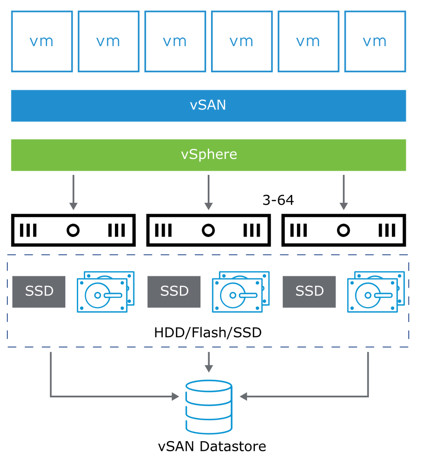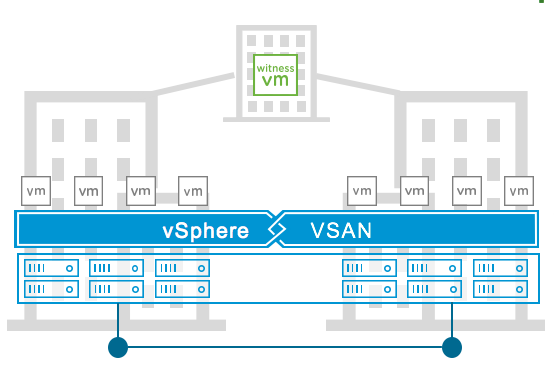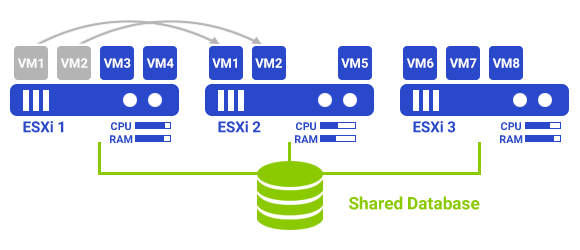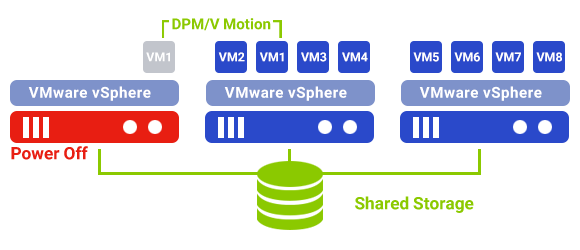Today, with the advancement of technology, even storage is virtualized. The reason is the possibility of scaling up or down all datacenter components without affecting the administrative services. Using storage space virtualization technology, it is possible to use local hard disks of physical servers for integrated storage of data and information. In this technology provided by EMC and in partnership with VMware called vSAN, local hard drives of physical servers are connected over the network and form integrated virtual storage. In this virtual storage, all physical servers have access to each other’s hard disks, and the Read/Write operation is performed on local hard disks. Like a physical storage space, there is the possibility of RAID and LUNs in this virtual storage space.

What is VMware VSAN?

VMware vSAN is a software storage product used alongside the VMware ESXi hypervisor that provisions and manages storage based on policies, regardless of the underlying hardware. This solution allows you to prepare your business for growth through its seamless evolution and development, integrated with vSphere and requiring no new tools, flexibility, and multi-cloud capabilities. As an industry-leading software, VMware vSAN delivers high-performance levels with minimal CPU and memory impact.
Fault Tolerance
vSAN Stretched Cluster is a unique configuration implemented in environments where avoiding disaster or failure is a crucial requirement. In vSAN, by setting up a cluster in 2 active/active sites with an equal number of ESXi hosts equally distributed between the two sites and a third vSAN Witness Host site connected to both active/active data sites. This connection can be low bandwidth/high latency. This way, vSAN manages failure and disaster scenarios and thus improves fault tolerance.


High Availability
Clustering and HA should be designed and implemented separately for computing resources such as RAM, CPU, NIC, and GPU. HA should be implemented independently for storage resources, data, and information. VMware vSAN has centralized management of computing and storage resources, so even with the loss of hardware resources in a Rack, other hardware resources can serve.
Security and Encryption
vSAN Data-at-rest (data-at-rest): In this service, data is encrypted in the storage process on the device, and the data lock is decrypted in the exchange between the hard disk and RAM. It is encrypted after it is saved back to the storage.
vSAN Data-in-transit: This service is used for encryption in vMotion and FT services. Data is encrypted in transit between existing hosts. Before sending, the data is encrypted, and after reaching the destination, it is decrypted by the new host.


Simplified file services
vSAN file services are famous for their flexibility and integration. The original version of vSAN provided massive read and write persistent volumes (RWM) for cloud applications in vSAN. vSAN 7U1 further improves file services capabilities with SMB v2.1 and v3 support, Active Directory integration, and Kerberos support. vSAN 7U2 extends the capabilities of vSAN file services in new ways, including support for stretched clusters, data encryption in transit, instant snapshots, and improved scalability, performance, and efficiency.
Deduplication and Compression
VMware vSAN has powerful deduplication, which means it avoids duplicate data. So, it has access to 0 and 1 of all vmdk of virtual machines because VMware vSAN is an Object-Level Storage. In addition, it has a powerful compression capability and compresses VM files. These two features help VMware vSAN in storage management efficiently.


SPBM
Since VMware vSAN is an Object-Level Storage, there is a management-based feature based on storage policy, where you can apply storage policy to all VMs and virtual machines. It means some VMs can be specified to be stored with Raid6 and others with Raid5 in VMware vSAN. In addition, it is possible to determine by tagging VMs stored only on SSD hard disks.
Advantages of VMware vSAN
Scalability
VMware vSAN allows administrators to scale storage on demand quickly and efficiently through dedicated policies and rules. It also mitigates the risks associated with digital transformation by leveraging existing tools, skills, and solutions.
Management
VMWare vSAN is easy to set up, manage and control without loss of performance. Configuring VMWare vSAN is simple because it is built into the vSphere Hypervisor, and installation can be done quickly using the vSphere Web Client.
TCO
VMware vSAN helps reduce upfront costs for businesses because it can be easily deployed on low-cost x86 servers. In addition, it’s a highly scalable infrastructure and rapid deployment. Also, it saves organizations time and money, making it an efficient storage solution.

